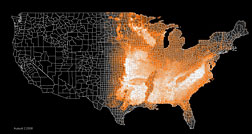- Number 368 |
- July 30, 2012
DataONE portal streamlines access to environmental data

Easier access to data through a new
search software from DataONE promises
to aid data-intensive research projects
such as eBird, which combined multiple
data layers to make predictions about
bird migration patterns.
Environmental researchers who investigate climate change, invasive species, infectious diseases, and other data-intensive topics can now benefit from easy access to diverse datasets through technology released by the Data Observation Network for Earth, or DataONE.
Understanding broad and complex environmental issues increasingly relies on the discovery and analysis of massive datasets. But the amount of collected data – from historical field notes to real-time satellite data – means that researchers are now faced with an onslaught of options to locate and integrate information relevant to the issue at hand.
DataONE, a ten-institution team including researchers from DOE's Oak Ridge National Laboratory, is addressing this data dilemma with a one-stop search engine called ONEMercury that queries data centers located around the world for relevant earth science information. ORNL is part of the National Science Foundation-supported DataONE team that collaborated on the newly released software, along with researchers from the University of Tennessee's School of Information Sciences in the College of Communication & Information, the University of New Mexico and other partners. At the heart of the new software is an advanced search engine developed by Palanisamy and colleagues at ORNL.
DataONE's search tool enables researchers to easily integrate previously incompatible datasets, as demonstrated by an ongoing project that is already yielding results in the field of ecology. A DataONE working group has combined a database of amateur bird sightings with environment data layers about land use, weather and vegetation to make refined predictions about bird migration patterns.
The tool is available to the public.[Morgan McCorkle, 865.574.7308,
mccorkleml@ornl.gov]
